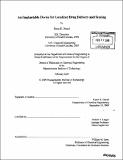| dc.contributor.advisor | Robert S. Langer. | en_US |
| dc.contributor.author | Daniel, Karen D | en_US |
| dc.contributor.other | Massachusetts Institute of Technology. Dept. of Chemical Engineering. | en_US |
| dc.date.accessioned | 2009-08-26T17:02:43Z | |
| dc.date.available | 2009-08-26T17:02:43Z | |
| dc.date.copyright | 2009 | en_US |
| dc.date.issued | 2009 | en_US |
| dc.identifier.uri | http://hdl.handle.net/1721.1/46608 | |
| dc.description | Thesis (Ph. D.)--Massachusetts Institute of Technology, Dept. of Chemical Engineering, 2009. | en_US |
| dc.description | Includes bibliographical references (p. 117-120). | en_US |
| dc.description.abstract | There are many potential clinical applications for localized drug delivery and sensing systems, such as cancer, vaccinations, pain management, and hormone therapy. Localized drug delivery systems reduce the amount of drug required for a therapeutic effect and the severity of side effects. Delivery of multiple chemicals has been demonstrated previously from a polymeric microreservoir device. This dime-sized device contains small reservoirs loaded with drug and separated from the outside environment by a degradable polymer membrane. This device was modified to allow minimally invasive implantation with a large-bore needle and has demonstrated in vitro pulsatile release of a model compound after a mock implantation step. A biodegradable sealing method was developed for the polymeric microreservoir device, which makes the device completely resorbable and eliminates the surgical removal step needed with a non-resorbable device. Localized sensing systems will allow early detection of diseases and provide a tool for developing personalized treatment programs. The polymer microchip platform has been combined with magnetic relaxation switch (MRSw) nanoparticle sensors to create an in vivo sensing device. MRSw are magnetic nanoparticles (iron oxide core, crosslinked dextran shell) that can detect a variety of analytes. MRSw are kept in the device by a molecular weight cut-off (MWCO) membrane which allows analytes free access to the nanoparticle sensors. | en_US |
| dc.description.abstract | (cont.) The MRSw aggregate in the presence of the analyte they were designed to detect and this aggregation causes a decrease in the transverse relaxation time (T2), which can be detected with magnetic resonance imaging (MRI) or nuclear magnetic resonance relaxometry. In vitro sensing experiments were used to optimize the device design and characterize its performance. In vivo device-based sensing of hCG, a soluble biomarker that is elevated in testicular and ovarian cancer, has been demonstrated. Cell lines secreting hCG were used to produce ectopic tumors in nude mice. The sensing device was implanted and magnetic resonance imaging (MRI) quantified a T2 decrease in mice with tumors compared to control mice (no tumors). This device may be the first continuous monitoring device for cancer that can be implanted at the tumor site and demonstrates feasibility of MRSw measurements in vivo. | en_US |
| dc.description.statementofresponsibility | by Karen D. Daniel. | en_US |
| dc.format.extent | 120 p. | en_US |
| dc.language.iso | eng | en_US |
| dc.publisher | Massachusetts Institute of Technology | en_US |
| dc.rights | M.I.T. theses are protected by
copyright. They may be viewed from this source for any purpose, but
reproduction or distribution in any format is prohibited without written
permission. See provided URL for inquiries about permission. | en_US |
| dc.rights.uri | http://dspace.mit.edu/handle/1721.1/7582 | en_US |
| dc.subject | Chemical Engineering. | en_US |
| dc.title | An implantable device for localized drug delivery and sensing | en_US |
| dc.type | Thesis | en_US |
| dc.description.degree | Ph.D. | en_US |
| dc.contributor.department | Massachusetts Institute of Technology. Department of Chemical Engineering | |
| dc.identifier.oclc | 426038124 | en_US |
